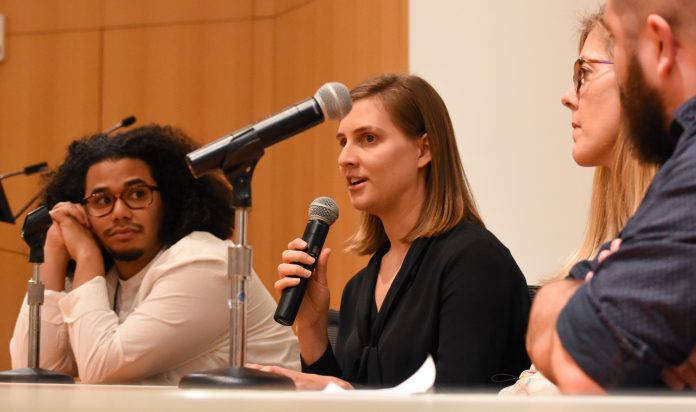
Pete Loganbill
Features editor
The college hosted its monthly Third Thursday event this week featuring artists Rena Detrixhe and Kahlil Irving, whose work is featured in the current Nerman Museum exhibit Ephemera.
Bruce Hartman, director of the museum, described the importance of the event and the significance of this particular session.
“It’s really an opportunity for us to focus upon artists that have a connection to the community,” Hartman said. “This I think was a particularly interesting [one]. We have always stressed diversity in the collection, and I think to have Kahlil here to start to address some of the political issues in his life … I think it’s important for our community to hear that.”
Irving began making ceramics at age 12, living in St. Louis. He was later accepted into the Kansas City Art Institute, and then went to study abroad in Jerusalem. When he came back, he began to make art out of trash on the street.
“I came back to the Kansas City Art Institute after studying abroad, and I would look at stuff on the street,” Irving said. “I started slip casting objects and slip dipping things in paper, or paper cups.”
His art is made to acknowledge racism in the United States. He incorporates images and newspapers in his work to tell these stories.
“It’s not necessarily legible at first glance, but it’s within the work, within the construction of what’s going on in those objects,” Irving said. “Michael Brown is remembered in my work.”
Similar to Irving’s work, Detrixhe’s also deals with hard issues, specifically the deep, complicated history of Oklahoma. She has created a Persian-style rug out of rich, red, Oklahoma earth.
“Rena [is dealing with] very politically charged issues as well,” Hartman said. “Many of the symbols within [the rug] are of oil wells, oil jacks, really talking about what we’re doing the planet.”
Detrixhe described what inspired her to make the piece.
“While walking I noticed the footprints on trails, indicators of human presence,” Detrixhe said. “It occurred to me that these footprints were the result of immediate impact, and the result of repeated impact over time.”
She stated that from a western perspective, a rug is something which is beautiful, used to cover, and also takes many hours of labor to make.
“Oklahoma was one of the last states to enter the union … and it’s only been a state for a little over a hundred years” Detrixhe said. “It was Indian territory for many years. Many tribes were relocated [there]. The Trail of Tears ended in Oklahoma. As a result, there are 39 federally recognized tribes in Oklahoma.”
Hartman believes the work of the two artists brings necessary awareness to uncomfortable issues.
“I think it was interesting to see two artists … working with the most basic material and yet they’re able to address these desperate social, political concerns,” Hartman said. “I think that’s an extraordinarily important conversation to have here at the museum and on campus.”
You can check out The Ledger’s coverage of Ephemera here.





















